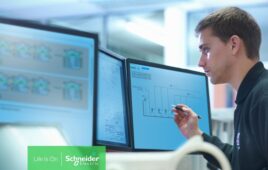
The manufacturing industry is undergoing a period of profound change. From a marketplace perspective, the customer’s appetite has grown for diversified products to be delivered quickly. On the technology side, next-generation product transport solutions and digital twins are opening up an entirely new era for machine builders and the manufacturing industry.
Online purchasing trends (e-retail sales surpassed $4.2 trillion worldwide in 2020) and the growing demand for customized products has pressured global manufacturers to reconfigure their product and packaging manufacturing while reducing time-to-market and operational costs.
Floor machines are forced to handle multiple formats on an ongoing basis, and the time required to set up these machines for different formats becomes an important productivity differentiator. Automation system manufacturers like Schneider Electric have responded by innovating multi carrier technologies and digital twins in response to these challenges.
How manufacturers can better respond to changing customization demands
Today, many manufacturers are not equipped to handle the new wave of customization demand.
Fortunately, with robotics as integral parts of machines, improved machine connectivity, data analytics, and the growing importance of software at the shop floor, significant transformations are already happening to help meet evolving marketplace needs.
Disruptive technologies, such as multi carrier transport solutions, combined with digital twin software adds innovation to this transformation.
Multi carrier product transport systems can move, arrange, or group products in the right positions at the right time. Together with the EcoStruxure Machine Expert Twin. Simulation suite, Lexium MC12 multi carrier enables:
- Flexible tracks built by modules
- Different carriers to move independently along the track
- Digital design tools to emulate different tracks, allowing to test and optimize applications beforehand
This brings a new level of freedom to fuel faster and more flexible machine designs, which helps end-user organizations achieve smarter manufacturing.
End users are increasingly aware of these disruptive new technologies and are ramping up the demand for these solutions. OEMs that fail to adapt will risk eroding their competitive marketplace advantage. Fortunately, manufacturers now make it possible to design such machines from toolkits, making adaptation relatively easy.
4 ways the multi carrier system facilitates machine motion-related tasks
The new generation of multi carrier transport solutions, such as the Lexium™ MC12, present significant benefits to both OEMs and end users:
- Up to 30% reduction of design and time-to-market – The Lexium MC12 multi carrier for OEM designers represents a true revolution in the machine design process. This technology introduces a new opportunity to differentiate from competitors through rapid solution development and improved design quality. Speed, flexibility, scalability, and simplicity are all amplified to drive never-before-attained levels of efficiency.
The next-generation Lexium MC12 multi carrier provides:
- Product transport tracks are built from standardized components which can be freely combined.
- A reduction in the number of format-specific parts.
- A packaged solution with digital twin software. Designers can now emulate a full track and immediately begin testing the machine before making the hardware available.
Together these capabilities allow design times to decrease while machine flexibility and functionality increase.
- Increase machine performance and flexibility by up 50% – Unlike traditional approaches, machine builders no longer need to choose between either performance or flexibility when designing machines.
- Operational agility – The new generation of multi carrier transport technologies enables more agile end user smart manufacturing. The changeover procedures needed to quickly move from one product format to another on one production line now can happen automatically. In fact, changes over time can be reduced, in some cases, to almost zero, which has a positive impact on the Overall Equipment Effectiveness (OEE). Customers who have piloted such systems report 50% less time for format changes that boosts production line outputs, especially when changeovers are common.
- Maintainability – The design of the multi carrier transport systems also provides a new level of simplicity in maintenance with:
- Smaller machine footprints and easy mounting and dismounting of components by field technicians.
- Unlike traditional transportation conveyor chains, electronics and sensors are embedded along the complete track to continuously monitor the machine’s health.
- Information can be provided to the operator on a real-time basis (for example, if a piece of rail has sustained damage or a surprising amount of high friction occurs somewhere along the track). This allows for maintenance to be planned on a proactive basis, which helps to avoid unanticipated downtime situations.
Sponsored content by Schneider Electric
Filed Under: Schneider Electric Sponsored Content




